GigaWatt LC-Y EVO cable, G-C16A Circuit Breaker and G-044 Schuko Socket
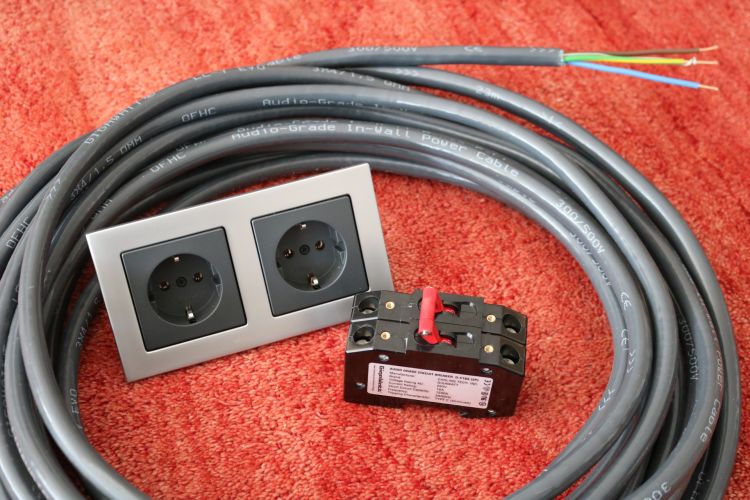
The Setup
In order to allow individual and repeated comparisons over a longer period of time, I installed all the GigaWatt products completely independently and separately from the existing infrastructure. The GigaWatt Circuit Breaker was installed in a vacant slot in the apartment’s standard utility box, fed internally by the exact same 2,5mm2 solid-core cable that feeds the standard Circuit Breakers. Similarly, the GigaWatt cable In-Wall was installed in parallel with the other audio groups, not inside the wall, but for this test, simply over the floor.
As an extra, I installed (also over the floor) a run of XMVK double-isolated 2,5 mm2 solid-core outdoor installation wire which is the same brand and type of cable that I used 10 years ago in the previous apartment and did not like at that time, just to see how it would behave now.
Along with the pre-existing uninterrupted run of regular 2,5 mm solid-core installation wire that I installed earlier (partially inside walls and partially inside cable trays) I normally use for the audio group, this leads to three different cables to compare, all in parallel and using individual, same-type, standard schuko socket outlets, in addition to the apartment’s standard in-wall cabling.
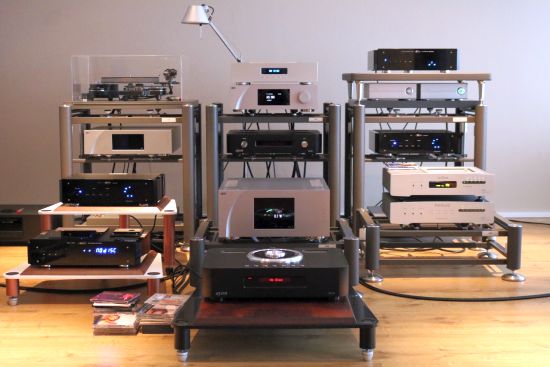
For all comparisons in this review, all the components in the audio system are powered from two fairly standard aluminum-case extension blocks which are connected to the audio group’s double schuko outlet via individual runs of regular 2,5 mm2 solid-core installation wire terminated with two Bals Schuko connectors.
To recap, installed in parallel are the following:
- Pre-existing, in-wall apartment wiring, 2,5 mm2 solid-core, interrupted in 3 places but connected with proper wire nuts.
- 14m of uninterrupted 2,5 mm2 regular solid-core installation wire (same type as above, partially in-wall, partially in cable trays)
- 14m of uninterrupted XMVK double-isolated 2,5 mm2 solid-core outdoor installation wire (over the floor)
- 14m of uninterrupted GigaWatt LC-Y EVO 3X4 cable (over the floor)
Kick-off
I will be kicking off the GigaWatt review by comparing the LC-Y-EVO cable to 3 other cables, starting at the apartment’s default in-wall cabling. For this first part of the test, the GigaWatt G-C16A 2P Circuit Breaker and G-044 Schuko outlet are not yet used. Instead, the above cables are used one by one using the apartment’s default automatic circuit breaker and basic schuko outlets.
For assessing the cables, I used various audio components in different combinations. The main components are the Antipodes CX+EX Music Servers, Jay’s Audio CDT-2 MkII and Aqua La Diva CD transports, CH Precision L1 preamp, CH Precision C1 and Aqua Formula xHD DACs and Magico S1 MkII and Martin Logan ESL15A loudspeakers.
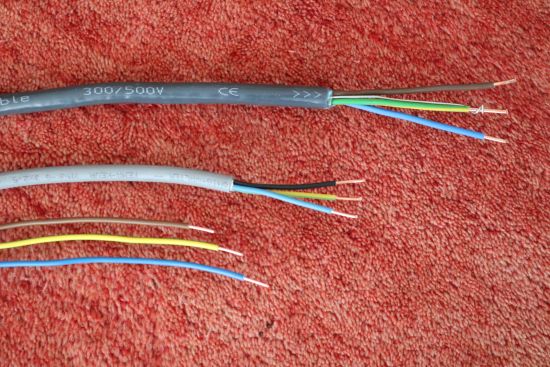
From top to bottom: GigaWatt LC-Y-EVO in-Wall cable, XMVK double-isolated 2,5 mm2 solid-core installation wire and 2,5 mm2 regular solid-core installation wire
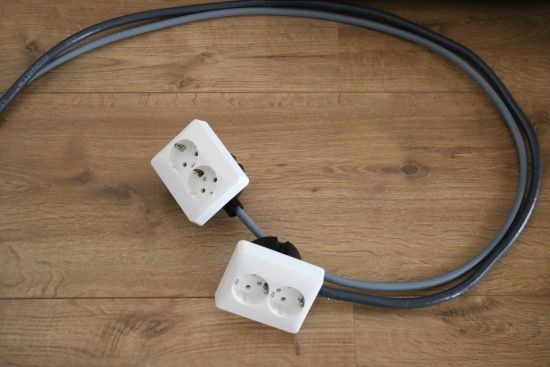
The cables were compared using identical standard outlets
2,5 mm2 solid-core installation wire
As I explained in part 1, after having replaced the snap-in connectors in all the ceiling light fixture points of the current apartment’s existing wiring with proper wire nuts, the sound had become more solid and more powerful with more sonorous bass and a cleaner and less nervous midrange and treble. It would stand to reason that the separate uninterrupted 14 meter-cable would have doubled down on the aforementioned effects but the changes actually occurred in different areas. It was not any more impactful or more dynamic but the definition had certainly improved. What I heard most was a certain cleanness and calmness and a lack of subtle grunge that made soft sounds and subtle decays stand out more.
Since the uninterrupted cable is exactly the same type as the apartment’s standard in-wall cable and the wire nuts allow the cables to connect directly rather than via a strip of metal, I would assume that the major causes for the observed differences are the various LED- and Halogen transformers as well as all the other equipment in the apartment that is connected directly along the way of the very same cable. In the case of the uninterrupted separate cable run these sources are of course ultimately still connected in the utility box but via a detour of over 30 meters and, apparently, that makes quite a difference.
XMVK double-isolated 2,5 mm2 solid-core outdoor installation wire
Before finally getting to the GigaWatt cable I have the XMVK double-isolated 2,5 mm2 solid-core outdoor installation wire another shot. If you recall, this is the cable that I found not to work well in my previous apartment. As it turns out in this setup as well, this cable sounds very dull. It’s slow, dark and thick and dynamically restrained. Worse, it is the antithesis of lyrical. Maybe it would work relatively well in a very aggressive system but I would definitely not want to use it for a well-balanced system. So, as it turns out, the issue back then was not with the separate audio groups but with the cable that I used!
Of course, one can question why this cable can sound so dire, if its core conductors are very similar, maybe even identical, to those of the standard in-wall wiring. Well, personal experience shows that insulation materials have a huge effect on how a conductor sounds. This cable uses three layers of low-grade plastic of which the outer two are very thick and very likely of the sort that stores energy and returns it with a delay. It is not a coincidence that fast-sounding cables often use PE or Teflon or similar higher-grade plastics.
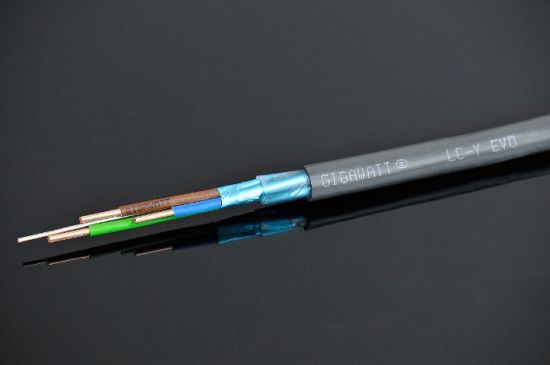
GigaWatt LC-Y EVO 3X4 In-Wall cable
The GigaWatt cable has an earth, a shield and a drain wire. As per normal connection methods I connected the earth on both ends but the drain wire and shield only on the source end in the utility box.
Having changed from the in-wall cable to the separate uninterrupted run of standard installation cable was certainly audible but relatively subtle. The change to the GigaWatt cable, however, was far from subtle! Tonally, the cable is very well-balanced, the antithesis of dry and relatively rich-sounding but not at all soft or smeared. The sound had become slightly more relaxed than with the standard installation wire but it was so much more refined and so much more involving, it’s uncanny. It’s as if the sun had suddenly started shining during a previously sober day. The entire delivery is sweeter, lusher and airier, much more organic and incredibly lyrical.
While richer and more relaxed and more organic, the sound remains dynamic. Soft sounds are soft and gentle and clearly articulated and loud sounds come across with full force yet never in an in-your-face manner. The treble is considerably more refined with lots of subtlety and air. It’s not smoothed, there is actually still very good percussive definition but now also seemingly eternal decay. The bass, however, is slightly more voluptuous and therefore also slightly less spritely and articulate than with the standard cable but here, too, the GigaWatt cable remains well-balanced, providing the extra fullness without becoming ill-defined or slow. Vocals gained an increase in focus and localization and feel close without being in your face. Finally, the soundstage now extends much more backward behind the speakers as a large bubble with much more clearly defined, more palpable and better-separated sounds within it.
Going back to the uninterrupted 2,5 mm2 solid-core run of standard installation wire made for a sobering moment as the sound had suddenly lost its organic nature and most of the rich and vivid tonality to make for a comparatively scanty, dry and gray sound. The resolution was not diminished and it was actually tighter and more articulate but a lot less refined. Vocals were less well-focused and appeared flatter in the depth plane. Piano still had its characteristic percussive quality but it was like it had lost some of its virtuosity as if the player was feeling a little off.
Wow. There are no two ways about this, is there? Well, despite the overwhelming goodness that the cable brings, as with all cables, it remains a matter of system synergy. Based on my comparisons using various sources and compared to standard in-wall solid-core cable, I’d position the GigaWatt cable on the slightly full-bodied and relaxed side of neutral. And, as it follows, some system matches will be more ideal than others.
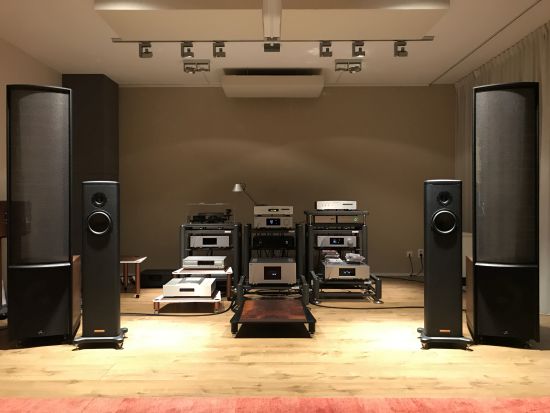
The GigaWatt cable turned out to be an absolute blessing when combined with the two relatively lean-sounding Aqua components and the CH Precision L1 preamplifier, either with the Logans or the Magicos. If this were my main system then the GigaWatt cable would have been the single missing link. It’s perhaps a little heretical, but in some ways, with the GigaWatt cable in place, I now preferred the 14K-Aqua DAC via the L1 preamp to the 40K-C1 DAC by itself via the standard power cable. Go figure!
When using the relatively fuller-sounding CH Precision C1 DAC (with any source) and the Martin Logans (which is my default system), however, I found that the GigaWatt’s more voluptuous sound did not pair ideally. While absolutely more organic and incredible in terms of imaging and emotional involvement, I found myself missing some of the tension and expression that the standard cable provided especially with more upbeat music.
When keeping the system unchanged and swapping from the Magicos to the Logans then the GigaWatt cable was a better match but also with these speakers, ultimately, I found the combination to be less synergistically as with the Aqua combo. However, at this point, the standard cable with its dry and matter-of-fact sound also did not really please me anymore. Now, what to do? Fortunately, GigaWatt would come to the rescue with another product.
Subsequent comparisons
After the above tests, I left all the cables in position and swapped between them over the course of over two weeks and during that time I found that all my observations remained exactly as they were. If any running-in or bedding-in occurred then I did not notice it.
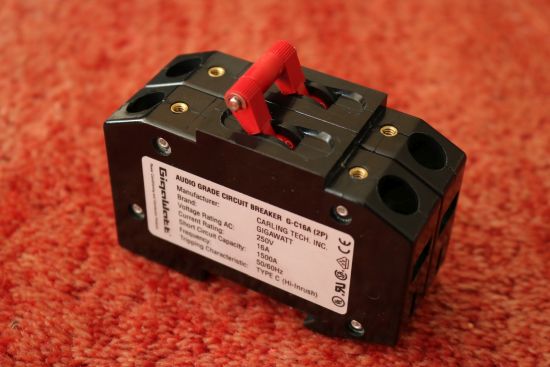
G-C16A 2P Circuit Breaker
Now it was time to listen to the GigaWatt Circuit Breaker. It was installed in the utility box in parallel to the exising Circuit Breakers, fed by the same cables, allowing me to switch the 14-meter cables between the Curcuit Breakers.
To prevent mixing up the results I started with the uninterrupted 2,5 mm2 solid-core installation wire, not the GigaWatt cable. After having first listened to the system using the apartment’s basic automatic breaker and switching to the GigaWatt breaker using the same cable my jaw fell to the floor.
The difference was so much more profound than I had anticipated that I had to switch back immediately just to make sure I had heard it correctly the first time. Yup, I did. Wow! What this unassuming unit did for the sound was bordering on the ridiculous. I mean, from my aforementioned experiments with the ceiling light fixture points I knew that tweaks further away yielded ever-smaller improvements but, somehow, the G-C16A 2P Circuit Breaker did it anyway.
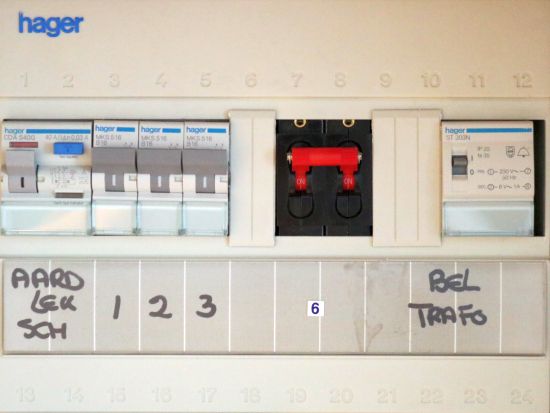
The new audio group is powered not from the adjacent earth leakage circuit breaker but from the second one below it (not visible in this photo) that powers fewer parts of the apartment. The GigaWatt switch may seem large when you unpack it but it fits standard installations after which only a small part of it is visible.
With the GigaWatt Circuit Breaker, the music had more pronounced acceleration and deceleration whereas the default circuit breaker seemed to maintain more of a robotic metronome-like constant tempo. The music was now living and breathing with fuller bass, richer colors and lyricism that had no bounds. The beauty is that there seemed to be absolutely no downsides to the effect as slow tracks were still pleasantly seductive yet fast tracks were speedy and exhilarating. Guitars and all other acoustical instruments were now more realistic and vocals had more breath. No matter what I played the increased “joie de vivre” was always evident.
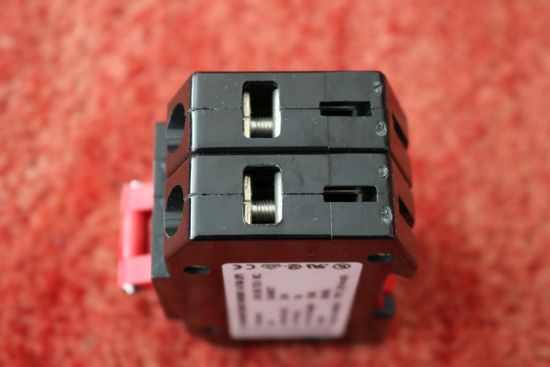
To a not inconsiderable extent, the G-C16A 2P Circuit Breaker had restored the balance. No, it is not a full substitute for the GigaWatt cable as using the two products combined quickly demonstrates but the Circuit Breaker does offer similar improvements. It provides precisely the right amount of color, fullness and organic texture while retaining an utterly neutral balance. And importantly, the Circuit Breaker turned out to be beneficial in all circumstances and without introducing any drawbacks, no matter the system that was used.
As with the cable, I left the unit powering the system for 2 weeks, just to see if its effect would change over time.
Two weeks in
After having used the Circuit Breaker for 2 weeks I switched back to the regular Circuit Breaker. Well, that certainly settled it! The regular unit was considerably grayer and more restrained. Also, dynamically, the regular Circuit Breaker was now decidedly unimpressive. Everything sounded smaller in scale and harmonically deprived. Subtle sounds were buried in the mix instead of leaping out but worst was that the gray timbre and the dynamic restraint made everything less real and therefore less involving. Yup, the G-C16A 2P Circuit Breaker was definitely going to stay.
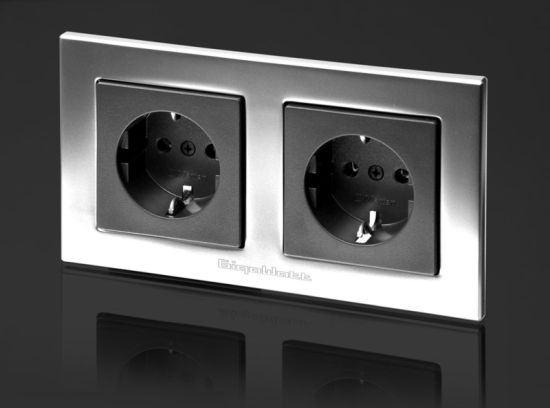
G-044 Schuko Wall Socket
This comparison was done by splitting the audio group’s main cables into two spurs (using proper wire nuts) of which one fed my regular wall outlet and the other the GigaWatt G-044 outlet. This way, I could simply swap the two Schuko connectors that lead to my system’s two power extension blocks.
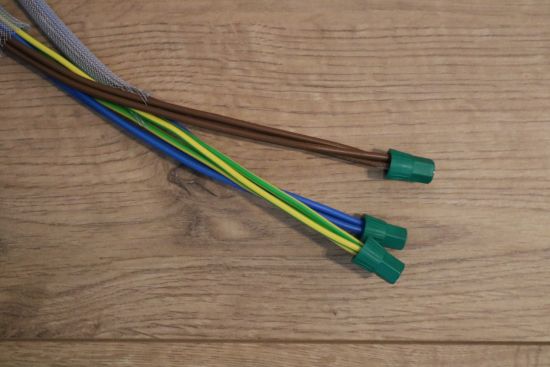
Honestly, at first, I was pretty skeptical about the Circuit Breaker, but it totally took me by surprise. Yet, even after having heard how much the G-C16A 2P improved the sound of my system, I was still afraid that the improvements with the Wall Socket, if any, might be too small to warrant the cost.
My regular outlet is an old-fashioned model but specially selected for still having screw-contacts rather than snap-in contacts. Having heard the negative impact of the snap-in contacts in the ceiling light fixture points, I definitely wanted to avoid outlets that use these. Sadly, everything available at the hardware store these days has snap-in connectors, hence the old outlet. But as the GigaWatt socket quickly illustrated, having solid wire connectors is only part of the story.

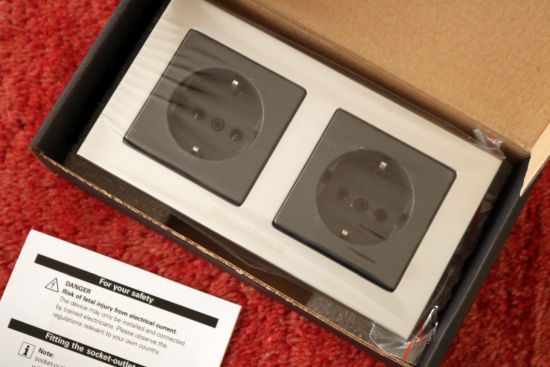
As with the circuit breaker, the sound became more involving by being more deliberate and better-textured. There was more “life” in the musical presentation but with a tonally full delivery.
The resolution of detail had also improved but without making the delivery analytical or introducing a feeling of artificiality.
There was definitely no edge or hardness but neither was the sound overly polished and certainly not dynamically compacted or less exciting, as can happen with certain high-end connectors and outlets. For instance, the Rhodium-plated and Gold-plated Furutech outlets that I used in the past provided a highly refined and polished sound but at the cost of a measure of propulsion, expression and dynamic impact.
Actually, the bass with the GigaWatt socket had become more incisive and impactful and the pacing more upbeat than with the standard outlet while retaining a very neutral “earthy” and sonorous quality, contrasting strongly with most Japanese specialist high-end brands.
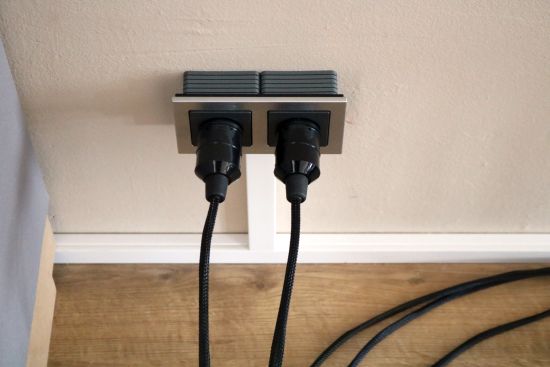
The Schuko Socket is not meant for on-wall fixation but with the help of universal accessories, this is entirely possible.
While the impact of upgrading from a standard outlet to the GigaWatt outlet is not as profound as the difference between a standard circuit breaker and the GigaWatt version, the difference is unmistakable. Perhaps not day and night but definitely the difference between a sunny day and a gray day.
Conclusion
There will always be skeptics who claim that circuit breakers, outlets and power cables could never have any meaningful impact considering the kilometers of standard cable that precedes our installations at home. While that may make sense on a logical level, all my experiments keep showing that everything you do to the electrical system actually does have an audible impact. Sometimes at the level of nuances but oftentimes quite profound.
The reality is that it is impossible for an audio component to make up for the losses that occur upstream in the power delivery. Yes, one could argue that a well-designed device should be able to work perfectly as long as it receives sufficiently low-impedance power with a voltage within its design limits. Some even go as far to boldly claim that any audio component that sounds different depending on the power cable or -connector surely must be badly designed. Well, if that were the case then all the components that I have reviewed over the last 10+ years must have been badly designed.
Nope, take it from me: good power connections do matter. A LOT! And as GigaWatt will gladly admit, that does not mean that one needs to resort to exotic materials with ridiculous price tags. Yes, GigaWatt products are more expensive than standard cables, circuit breakers and outlets but that’s only fair as they are custom-produced on a much smaller scale. Ultimately, what matters most is that these products do indeed also provide superior results. Best of all, even the smallest upgrade will already yield audible improvements meaning that you can start with the Circuit Breaker and work your way up as your budget allows, further improving the performance with every step that you take.
For me, there was no way that I would go back to the old situation and so I proceeded to make the Circuit Breaker and Schuko Wall socket a permanent part of my system.

(G-C16A 2P Circuit Breaker and G-044 Schuko Double Wall Socket)
Read Also
External Links
Distributor for the Netherlands: Ohm Audio
Manufacturer: Gigawatt.eu

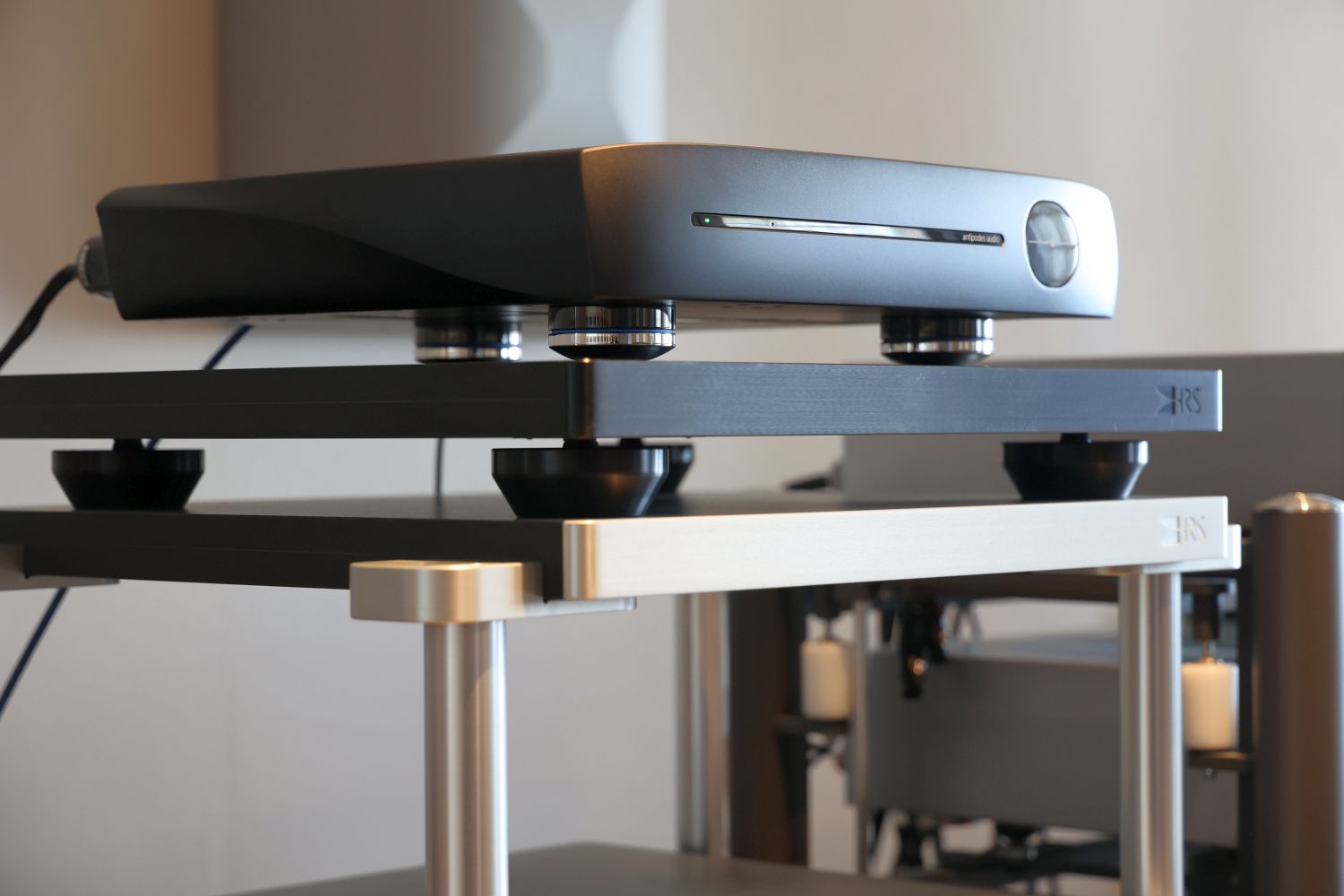
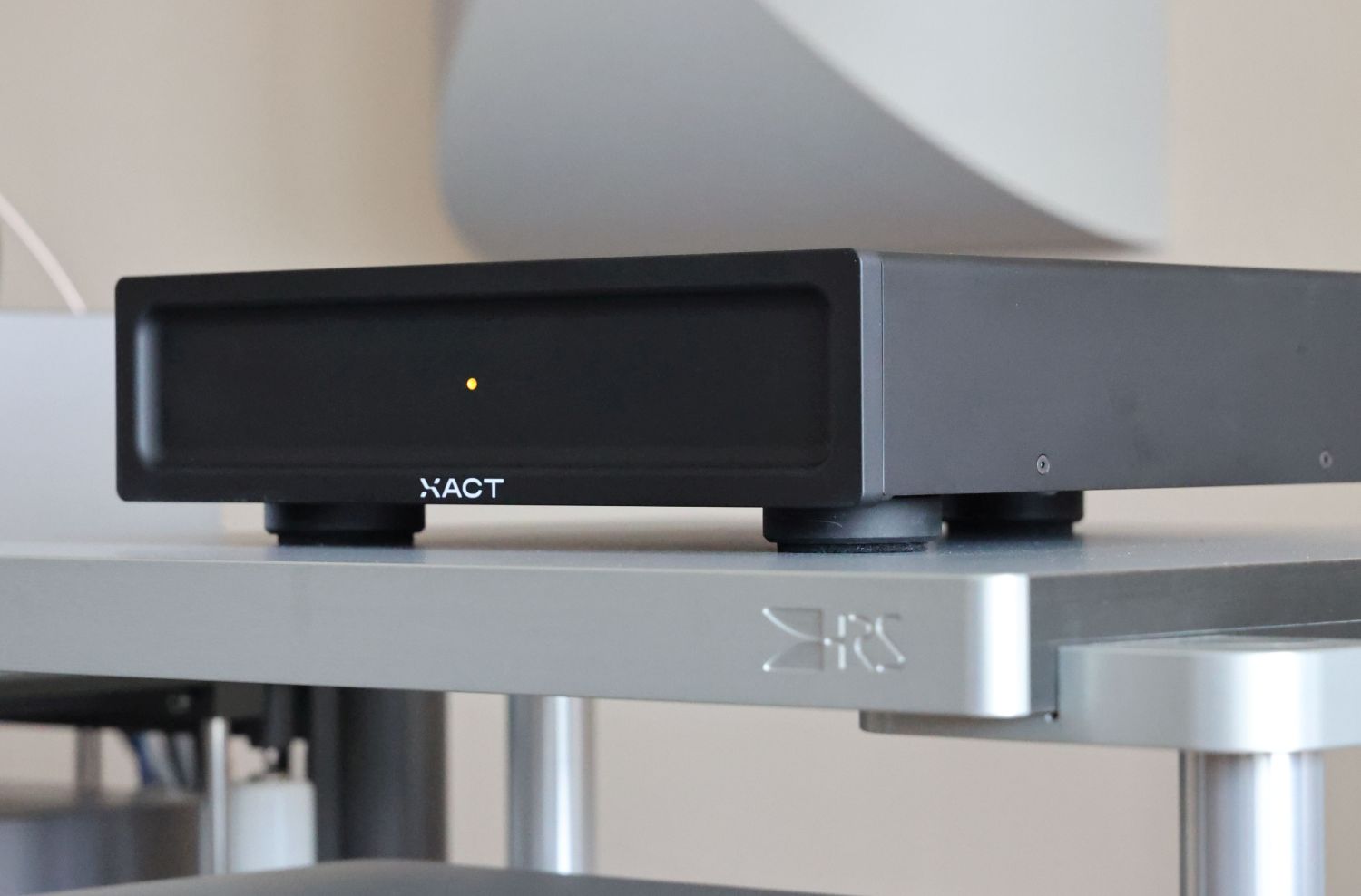
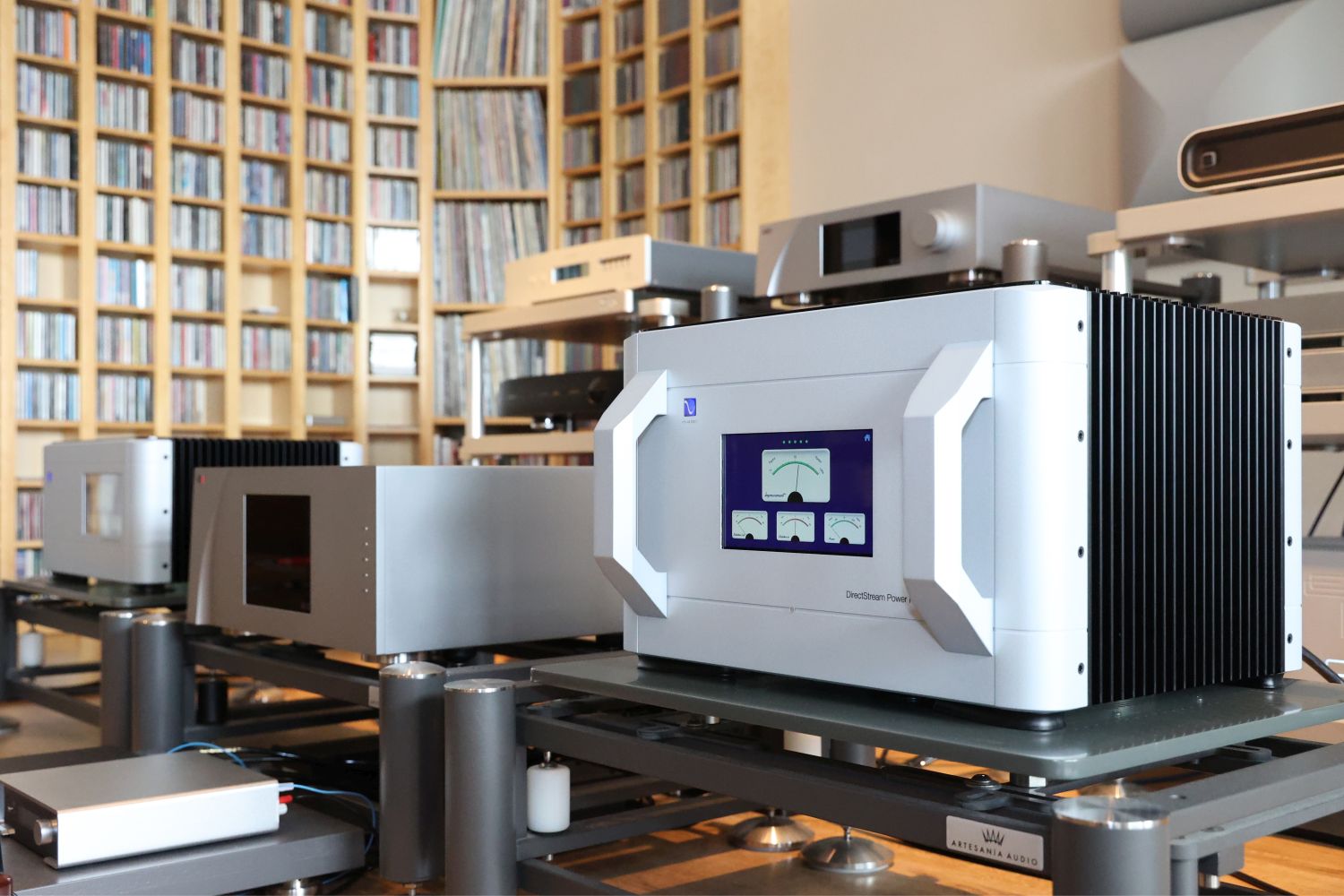


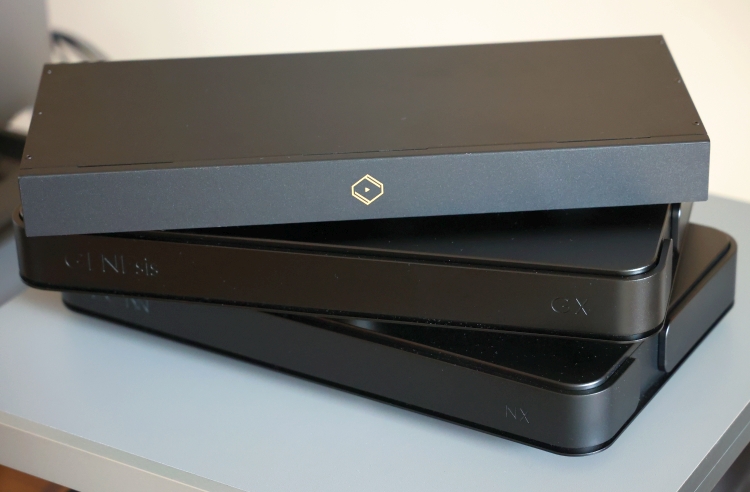
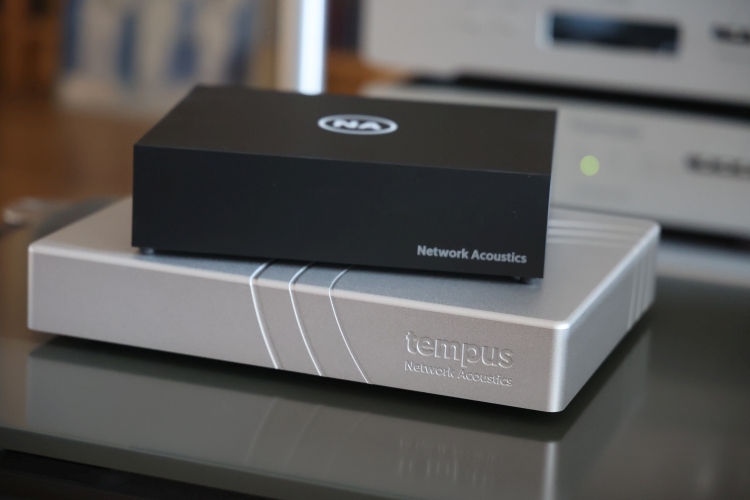
Next step: a test of a GigaWatt power conditioner! 🙂
Indeed:-)
Hi Christian
Is jouw vergelijking met een standaard zekeringhouder? Ik heb zelf de Kemp Ultimates en vroeg me af of de Gigawatts daar een verbetering in brengen
The GigaWatt circuit breaker was compared to the building-standard Hager MKS 516 automatic circuit breaker. This is not a fuse holder but a device that is comparable in operation to the GigaWatt. In regards to the Kemp Ultimates, I think you’d best check with Ronald Kemp but I think that the GigaWatt will indeed be better as it seems to surpass anything that contains a melting wire.
Hi Christian,
Interesting review but I’m a bit lost on how you conducted it also on the differences in buildings and AC in the US and Denmark perhaps. Here in the US the type of rewiring you did would be inside/behind the walls. Was that the case for you and if so how did you manage to change wiring so often I would imagine it’s very labor intensive. Or was this done in your dwelling and not in the walls?
Thanks,
Jon
Hi Jon, I updated the review to make this clearer. The apartment’s standard (interrupted) cabling is inside round PVC cable tubes inside the walls. In some places inside plaster walls, in some cases inside concrete. In the Netherlands, we have no hollow walls in household buildings unless they are really old. The initial replacement wires were installed permanently, where possible inside the plaster walls, where not possible in a cable tray over the concrete walls. The XMVK and GigaWatt were laid out over the floor.
Thanks Christian that makes perfect sense now! And well done review as always.
A great read Christaan!
Thank you for doing all the hard work. In a few days I plan to install one or two separate AC line(s) with standard breaker *. Since you had several cables, I was wondering if you also tried (or maybe not on purpose) to split in two AC lines?
In theory separation of analog and digital (or the amplifier on its own breaker) should be an other advantage. (Maybe one to try for later).
Keep safe and healthy,
Paul
* Are you aware of any comparable breakers in Canada or USA? The code is different here and the choice probably limited. According to code I need to install Arc Fault Breakers.
Hi Paul, sure, in theory that is a sound idea. I’ve used 3 separate spurs a long time ago but these days, with all equipment containing some form of digital processing, network capabilities or switching power supplies, it’s hard to keep it all strictly separate. That said, the ultimate method would be identical runs, one for each component. But one would also need to pay attention to ground planes and other interconnections. Some experimentation will be required.
GigaWatt circuit breakers are built by Carling (USA) which should have outlets over there and may even be able to supply the GigaWatt-specced units. The GigaWatt units are specified for 16A/250V 50/60Hz and they may well be compatible with any other power source that does not supersede these values. But I would definitely double check with GigaWatt on this as I am not a trained electro technician and most of my knowledge in this field is based on European standards.
Update: Arc Fault Breakers are what we in the Netherlands call Aardlek schakelaars. We have these, too, in circuit upstream of (in series and prior to) the GigaWatt “regular” Circuit Breakers. The Arc Fault Breakers detect slow electrical leaks which can occur when wiring is compromised but not completely shorted, which could cause fire. There are high-end models for this in the EU too, for instance by Doepke, but they are very expensive.
Hi Christiaan,
Thank you for the feedback. I enjoy very much reading your audio experiences and many ideas from your cues and test results can be found in my current ”very basic but great enjoyment” set-up. Very inspiring, I really like what you are doing ,please keep up the good work!
Hello Christian,
Do you have some details regarding the universal accessories for on-wall fixation of wall socket ?
Thanks for your help.
Hi Patrick, I used filler rings that are normally used to fit deep sockets into not deep enough wall cavities. The ones I selected are 10 of these moulded together. One is supposed to cut off the required amount but I simply left all 10 of them intact. Then, I attached the sockets using long screws straight into the wall with the filler rings in-between. Alternatively you could also use on-wall fixture boxes but these tend to be bulky and I preferred the cleaner look as achieved with this home-made solution.
Just a question regarding the installation of the 16A circuit breaker, in the picture it looks like it has been installed 180 degrees rotated. I have the 20A version and the connections on the gigawatt circuit breaker are opposite from the “Dutch” fuseholders. When switched on, the lever points down when correctly installed.
(the drawing of the Gigawatt marks the correct side to put the load)
Maybe the 16A is different ?
You are right:-) I observed the instructions on the Gigawatt leaflet but wanted the switch to have the same orientation as my other switches and so I mounted it upside down.
Hi Christiaan,
Thanks for the very interesting review. I also have some experience with using outdoor power wiring compared to default in house wiring. I came to the same conclusions as you. Apart from the extra insolation of outdoor wire it can also be coursed by the fact that the wires are held tight to each other where in house wires have free space between each other inside the tubes (induction or other bad influences).
Kind regards,
Dick
Hi Dick, glad you found it interesting. The space between conductors may certainly also be a factor indeed.
Hi Christiaan,i am using a single 16A Gigawatt circuitbreaker i compared it with direct on the mainswitch just behind the mainfuse and with the gigawatt.There is a difference in sound i found out, did you try that already?
Kind regards,Rik
Hi Rik, I’m sorry but I’m not sure if I am following what you are saying. Are you comparing the GigaWatt output to the direct Main Switch output?
Yes,but i think it is not a common switch but a circuit breaker too it comes after the main fuse?i mounted the gigawatt now direct on the blue and Brown wire of the mainfuse.i just listen to it for 15min ,must say sounds very clear
Hi Christiaan,Just listen direct on the mainfuse strangly it sounds not good i am a bit confused now.So like gigawatt say the gigawatt must be placed after the switch.
Hi Christiaan, Just some info about the switch before my gigawatt,it is a magnetic switch with also a bimetal.Still strange it did not sound good direct on the main fuse but it is possible a burn in problem probably my Cardas cables.
Hi Rik. in audio, “Good Sound” can be a relative term. Technically, the sound with audio components fed straight from the mains fuse/switch should be better than via a successive circuit breaker, no matter the brand or quality. However, I can imagine that you prefer the fuller and more organic sound that the GigaWatt induces over the relatively drier sound direct from the main fuse. In any event, it is not safe to bypass a circuit breaker and I would not advise to do that. The same goes for the Differential Switch (aardlekschakelaar).
Thanks,Christiaan, if i understand it correctly you place your gigawatt behind the differential switch then?it is true that the sound is warmer with the gigawatt must be coilmagnetism then from the gigawatt as well?
Hi Rik, Although some people bypass the Differential Switch (aardlek) for SQ reasons, this is not allowed nor recommended. In any event, the correct order is Main Switch or Main Circuit Breaker –> Differential Switch –> (Audio-)Group Fuse/Circuit Breaker. Just why the GigaWatt sounds warmer I could not tell you. A standard Hager circuit breaker has a similar mechanism with a similar coil but sounds cooler…
Hi Christiaan,the original magnetic main switch(16Asiemens)sounds here also cooler.But the gigawatt connected direct on the main fuse sound stressed a lot.I have now connected my hifi-tuning gold fuse back again after the Siemens switch and sounds more natural softer maybe less dynamic.I want to try the hifi-tuning fuse direct on the main fuse and hear what the difference is,but a bit tricky without disconnecting the main fuse?
Hi Rik, I’m surprised by your comment about the stressed sound. My only explanation would be that it sounds “squarer” and more direct and therefore subjectively “less musical”. However, I am assuming that your HT gold fuse has seen lots of use so the sound of the GigaWatt might become sweeter with prolonged use.
Just connected the hifi-tuning fuse direct on the main fuse? The 0 still connected to the magnetic switch.WOW what a huge difference lot more airy and much less distortion as well!But according to the gigawatt wich sounds bad direct on the main fuse i am wondering if the 16A limit is the issue.
Whatever the cause, I doubt it could be the Amperage rating.
yesterday i connected the zero as well directly on the main fuse sounded fantastic,open big soundstage and clear without any distortion..
Ah, ok. Good to hear.
Hi Christiaan try a 2p meltwire fuse direct on the mainfuse, hifi-tuning is the most affordable there are beter ones but very expensive you be amazed about the sound.I am not happy with the sound of the gigawatt.
Hi Rik, these things remain relative, of course. Just to put this in perspective, in what way do you find the HT to sound better than the GigaWatt?
Direct on the main fuse;sounded harsh and stressed, not good.
After the magnetic circuitbreaker it sounded better it seems to have more dynamics as the HT but the sound is much less natural and causes fatige.HT is much more sophisticated open and deeper imo gigawatt is nothing special(sorry)But after putting the HT direct on the main fuse that was the missing link in my gear.
Thanks for the extra info, Rik. That may well help others with their decision making.
To comply the VDE regulations our breaker is tested to IEC EN 60934 VDE 0642 (circuit for equipment for household).
An additional backup fuse isn’t obligatory if you will use this breaker to protect a single dedicated power line. Anyway most of household installation include main protection (20-32A) in front of our G-16A breaker and then declared Short Circuit Capacity (Icn) is 5000 A (instead of nominal 1500A).
Hi Christiaan,
This wrote Gigawatt to me,
Regards,Rik
Hi Rik, it’s interesting that the person at GigaWatt is talking about a backup fuse. Maybe something got lost in the translation? I’m no licensed technician and won’t pretend to know better than the people at GigaWatt but I’m quite certain that a Differential Switch (aardlek schakelaar) is obligatory between the main fuse/switch and the group fuse/switch.
Your might be right,but there is to much difference not bypass this differential switch but also the main (Magnetic)switch gives so much distortion and dull sound.But Kemp who is a technician who gives also the advice to place a 2p fuse direct after the mainfuse.
Yeah, that’s the problem. Once you heard the difference, it is difficult to go back:-) Ronald Kemp is well-experienced and a licensed technician but he is also an audiophile. He will likely have provided this advice based on audiophile grounds. In any event, the risk is very small and it’s entirely up to you if you are willing to accept that risk. As a reviewer who swaps devices on a daily basis, sometimes connecting early samples and prototypes, I prefer to be on the safe side.
Haha yes i understand that.Keep up the good wrok Christiaan!
Hi Christiaan some important info again, Antoine of Peacockaudio said the same things about the gigawatt,but he also said that it takes 800-1000hours of burning in. And are after that better than all other fuses! I just returned mine to Kemp with 30euro loss because of the screws were used.?
Indeed, I’ve been told that, too. And while there is indeed a development in the Circuit Breaker’s sound, I would not classify the difference as very large or, indeed, make-or-break.
As a Swiss engineer once told me, after 1000hours burning in you are burned in ?
FYI, at Action you can by a buildin wall socket in which the conductors are mounted with screws. The build construction looks good and the contact area looks te be sufficient. Particularly if you consider the costs.
What happened to part 2 of the review? I get a 404 error.
I changed from separate parts to using pagination (the arrows at the bottom of the article) to divide articles and this link was still using the now non-existing second part. It’s corrected now, thanks for the hint!
Thank you!
Christiaan, thank you for your thorough review. I ordered the GC 16 A with the Gabriel gdl 90 chip. Did you review this combination? I experienced immediately a kind of rest in the sound. I address that to the Gabriel chip. But I ‘m doubting if it could also impart the openness of the sound. Do you have a same experience ? Or didn’t you also use the Gabriel chip for that reason? Problem is I don’t think I can detach the chip for comparison without destroying it.
Hi Mark, Alas, I have no experience with that chip. I suppose that the Gabriel chip will be as with any tuning: it can have positive as well as negative effects.
I Mark,It is a while ago but i also tried out the gabriel chip.And i sent of back ,it was not a succes in my system,it is to long ago but i remembered the same problem.
Thank you, Christiaan for your very insightful and helpful reviews on this site!
In this review you mention that the GigaWatt LC-Y EVO cable could be somewhat too much in terms of warmth/fullness added depending on the other components in the set.
My question: do you think this still holds when all components in the set are powered through a power plant? My high-end audio set is powered with power regenerated with the PS Audio P15 power plant, I am interested in powering the P15 via this GigaWatt cable.
Hi Herman, the only PS power plant I heard was the PPP. It made the sound a lot tighter and articulate and more dynamic but with a lot of control, too much for my taste at that time. If the newer and bigger power plant has a similar effect then the Gigawatt cable might work very well indeed. One of the PS Audio Power Plant’s main establishments is that it lowers the output impedance which will I suspect will also reduce the amount of warmth that a cable adds.
Hi Christiaan,
I’m thinking to buy the Gigawatt 3x4mm to replace my Hifituning cryo cable. Unfortunately my Oyaide (palladium gold, like 046) can handle 2.6mm.
Unfortunately there is not so much choice in EU wallsockets. Have you heard the Furutech wall socket with ncf face plate? I know you didn’t compare them directly, but maybe you have listened to it in a other setup?
Ps: I’m afraid the Furutech house sound will take over. I don’t like the artificial detail some Furutech cables add. Therefore I Like Oyaide and Wattgate plugs, were music sounds more authentic.
I have not heard the G-044, but I had a Gigawatt circuit breaker and zgigawatt PF2 mk2 powerfilter at a time where I had a beginners setup and found the sound to grey and mechanical. My setup has greatly improved and there is a chance Gigawatt will sound just right/ neutral instead of grey/ mechanical. Still I’m curious about your findings!
I could also rejuvenate the contact points at the point of connection to the wall box. But I’m afraid the contact surface would then be less even and in the end the sound quality gets worse..
Hi Nick,
Alas, I have not heard the Furutech NCF Wall Socket. But having used the Furutech Nanoflux speaker cables and power cables, and knowing Furutech products in general, I think I can safely say that the character of the outlet will lean toward the fluid and refined side, just as you may already assume. Indeed, if you’re worried about the Furu house sound then I would be careful not to use too many of their products. Then again, I can understand your fear of getting an overly bland sound. But if you think the GigaWatt circuit breaker sounds grey or mechanical, then I suspect you are accustomed to a smoother and fuller sound than I have come to find ideal in recent years. For me, the Gigawatt circuit breaker sounds quite smooth and rich, so much so that I changed it to the Siemens Sitor, which I think will sound too lean for your taste or system. For me, the Gigawatt outlets are perfectly neutral but you may find them to be too “normal”.
Still, my personal belief is that one should not color or enrich the sound on the power side but deliver the power as unaltered as possible and choose the components to work synergistically. Then one can add any enrichment or smoothness, if desired, with line-level cables, speaker cables, component setup and other tweaks. Once you have taken away some energy/excitement/dynamics/egde (name it however you will), on the power delivery side it is very hard to get back downstream.
Hi there Christian my name is Myra
I am living in Canada near Vancouver originally from Britain
Where would I buy the gigawatt equipment
I have installed 2 dedicated circuits with hospital grade plugs which have a built in surge protector.
I am streaming music from the naim uniti nova
I have DH labs speaker cables, power cord and Ethernet cable
Gaia speaker feet
Upgraded the internet to fibre optic with a new router
I want to make a better quality electrical cable for the router
Buy an Ethernet switch
Some people say it’s better to buy a router that is more designed for music although the local internet provider does not support that box.
How would you advise me
Thank you for your time
Myra
Hi Myra, please look here for the distributors. There is a major debate going on about ethernet switches. I prefer to refrain from adding any recommendations on the matter but will say that, while there are certainly meaningful differences among switches, it is also highly relative. Fiber Optics are a great way to further increase galvanic isolation (it’s already built into the basic Ethernet spec) but even then, the switch at the endpoint will still matter.
The best advice that I can give is to be aware of what it is that you seek in terms of SQ, then compare two or more products and make up your own mind. It also pays off to compare a couple of power supplies for the switch or router.
Hello Stephaan, how are you?
I am coming back to you for advice!
As I told you previously, I installed a dedicated mains line and an electrical panel for my hifi and home cinema system, which starts from the general meter! In this specific electrical panel, I have a Doepke DFS2 differential circuit breaker and a Gigawatt G-C16A circuit breaker.
Do you think that you can install several wall sockets (Gigawatt G-044 for example) from the Gigawatt circuit breaker, using as you did, rigid single wire 2.5 mm?
On the other hand, do you think the Gigawatt G-040 socket (which requires making a hardwood box!) Can be a good cheaper alternative to the G-044?
Thank you for your help and valuable advice!
Take care of yourself !
Best Regards
Pascal
Hi Pascal, running a couple of outlets from a single lead should not be a problem. After all, you’re doing the same when using a power distribution block. Ideally, they’d be connected from the same central point branching off your new main lead. I’ve not heard the Gigawatt G-040 sockets so, alas, I can’t tell you if and how they differ sonically from the 044’s.
Hi Christiaan ,
Excuse me for having given the wrong name!
Do you think the jackets and insulation of the Gigawatt cable is responsible for how you feel when listening to the 2.5mm solid core cable? I think about it, what if we removed all the insulation or sheaths of the Gigawatt cable (except the insulation of the conductors of course!) To make it like 2.5mm solid core cables, unlike the Gigawatt cable. 4 mm conductors! what do you think about Christiaan ?
Best Regards
Pascal
Hi Pascal, no worries:-) Indeed, I think that the insulation has a lot to do with this. Removing the outer insulation might indeed make a very noticeable difference. You could try it first with a 2-meter piece. Do let me know the results! Just note that it will officially be mandatory to use these wires inside a cable tray after that.
Hi Christiaan,
Thank you for your comment – not long afterward I ordered the three Gigawatt items of this review plus the Doepke DFS 2 F Audio circuit breaker which you also reviewed. I am very happy with the substantial improvement in sound that resulted. With respect to my question on warmth/fullness added – I am happy that no warmth was added through this change. Probably a small amount of fullness was added, which I was not looking for but which turns out to be welcome.
By the way, the PPP you mentioned is now a relatively old model power plant (several generations back) – I would characterize the effect on sound from my current-generation P15 more as follows: the sound is more
Thanks for the feedback Herman! PS, it looks like a bit of text fell off at the end of your comment.
Clearly, Dutch wiring codes and standards leave much to be desired. Maybe I missed it, but did anyone ever address exactly WHY changing to wire nuts made the difference? Minimal contact area is only the beginning of what’s occurring; A-spots, burnish-wear, particle buildup, increased resistance, increased heat, further loss of contacting surface. Those ‘clip’ connectors serve one purpose: reducing contractor labor costs. That’s it. They are fire and safety hazards. Wire nuts, screw nuts, screw blocks, terminal blocks, or any method of firmly compressing wires together (to maximize surface contact) while preventing movement of the contact surfaces under stress are all excellent ways to connect wires safely, securely, and with maximum transfer efficiency. Or, you could just get a smaller amp.
Christiaan, what was the reason for changing from gigawatt gc 16a to the Siemens fuseholder in March 2022 ?
Hi Mark, My change from the Gigawatt switch for the Siemens Sitor followed a series of subtle and less subtle changes to my room and system in order to further enhance the system’s neutrality, linearity, transient behavior, dynamics, and expression.
In short, when I first added the Gigawatt, I needed and wanted the warmth and fullness that it provided, especially its fuller bass, as my room was eating a lot of the bass due to cancellations. See also the Latest installment of the HFA history where this is further explained).
When those issues were addressed acoustically, and my bass became much fuller, I found myself wanting a leaner, tighter, and faster sound. When a good friend and colleague reviewer mentioned that he used Siemens Sitor which he felt was the most neutral switch he had used, I followed up and got myself one which I had installed in parallel to the Gigawatt. Over a couple of months, I switched back and forth and decided that the Siemens was the better one for my new situation. Oh, I use the standard fuse as the friend indicated that the more upscale models add warmth which I do not need.
Hi CHRISTIAAN. Thanks for review. Can You specify what exactly model Siemens Sitor did You use ?
AFAIK, there is only one Siemens Sitor Cylindric Fuse Cartridge. The differences are in the fuses. I use the standard silver-plated one with a solid silver rod for neutral.
Very nice blog, where we can follow development on this theme. How did you connect the auxiliary bare wire on the Gigawatt distribution cable?
The drain wire was connected to the earth at the source end (Gigawatt switch) and left unconnected at the destination end (Gigawatt wall outlet).
Hi Critsian. Thank You for this infotmative review. I have also gigawatt g-16a and i notice that he can be too rich in sound compare to standart. Can You specify exactly the model of Siemens Sitor ? Thanks
Christiaan,
Ik heb een vraagje over de Gigawatt zekeringhouder. Ik heb hem zelf ook en vind dat hij veel rust geeft in het geluid, met behoud van transparantie in het hoog. Ik heb echter twijfels over transparantie en definitie in het laag. Omdat ik toen ik hem installeerde versleten elcos had, kon ik de verbetering niet goed analyseren. Nu mijn nieuwe elcos ingespeeld zijn heb ik dus twijfels over de laag definitie. Jij gaf aan dat je de bas iets teveel van het goede vond met de huidige plaatsing van je speakers. Maar hoe ervaarde je de laag definitie? Het kan ook zijn dat ik het ergens anders in moet zoeken, zo’n meterkast zekering swap ik qua werkzaamheden, niet even voor de lol.
Alvast bedankt voor je antwoord.
Met vriendelijke groet, Mark
Hi Mark, like you, I prefer the bass to be articulate and precise. So, I understand your doubts and can confirm that I heard the same on my end. Whilst the GigaWatt Circuit Breaker provided a beautifully rich sound with a very wide soundstage, ultimately, I wasn’t happy with the bass. I decided to have a Siemens Sitor circuit breaker placed next to it, such that I can switch between the two. In comparison, the Siemens provides almost the inverse sonic signature: lean, tight, articulate, and highly focused, if not as wide-imaging, and comparatively dry and clean-cut. I will admit that I have had to get used to the no-frills direct sound of the Siemens switch, but in the end, after having switched back and forth a couple of times, for my taste and system, it works well.
Hello Christiaan,
I too would like to test the Siemens Sitor circuit breaker, instead of my Gigawatt, can you give me a purchase link for the exact model you are using please ?
Thank you very much in advance !
It’s called “Siemens Sitor Cylindric Fuse Cartridge”. I used it with the standard fuse for hot and a silver-plated rod for neutral.
Christiaan, I was doubtingabout purchasing the Gigawatt 044 outlet, but decided to buy the Schnerzinger wall outlet. I did not compare them, but must say I am very pleased with the reduction of smear, increase in detail without increase of
grain and better dynamics as well. Would it be an idea for you to test the Gigawatt 044 side by side with the Schnerzinger? I think the performance would fit your preferences.
Hi Mark, it’s a nice suggestion and I’ll keep it in mind.
Good evening, I’m using Lapp Kabel Olflex 110CY 3×2.5mm line from the electrical panel. At one point I used Inakustik AC2502m, but it was very strict, direct and dry, so I went back to olflex, This was richer and softer, and I like it, GigaWatt LC-Y EVO compared to olflex how does it sound??Is it softer and smoother?thanks
It’s been some time since I heard any Lapp cable but I would say the Gigawatt LC-Y EVO is smooth but more solid and articulate than Lapp, certainly not smoother than Lapp. Please note that LC-Y is very stiff and only intended for in-wall use or as a main cable that is not moved after installation. It’s not ideal for making separate power leads.
@Kostas I find the Gigawatt somewhat grey/ neutral and not rich if that is what you looking for. Furutech is rich and smooth.
Yes, I will agree, because I also have a furutech. Of course, the cost for multiple meters as a separate line is high, thank you very much to all of you, I should also point out that I have a Hifi tuning fuse in the electrical panel and a Gigawatt socket
Hi Christiaan,
Did you besides circuit brakers also compare “aardlek” switches or is there a certain type that you are using?
So far, I haven’t had a desire to go there:-)
Hi Christiaan,
I have the Gigawatt circuit breaker for a while and to my feeling it reduces the speed of the music a bit and reduces the Naim’s famous PRaT from it. Also it the bass becomes a bit rounder and more bloated compared to the standard CB.
Is there another brand that you can recommend over the Gigawatt and do you recognize the above as well?
I have a Naim 333/332 combination with active ATC SCM40’s.
Dank je!
Thank you for sharing. Maybe that’s the reason Christian changed it later on?
Quote:
Main System 14 – August 2024
« The power for this system is delivered by a dedicated run of solid-core installation wire, sourced in the Breaker Box from a Siemens Sitor Cylindric Fuse Cartridge and ending in three GigaWatt G-044 single Schuko Wall Sockets behind the audio system. I use three power distributors: one for the main system, one for analog, and one for review components.«
Just read the comments above from november ´22. Make sure it is allowed according to code in your country.
« I understand your doubts and can confirm that I heard the same on my end. Whilst the GigaWatt Circuit Breaker provided a beautifully rich sound with a very wide soundstage, ultimately, I wasn’t happy with the bass. I decided to have a Siemens Sitor circuit breaker placed next to it, such that I can switch between the two. In comparison, the Siemens provides almost the inverse sonic signature: lean, tight, articulate, and highly focused, if not as wide-imaging, and comparatively dry and clean-cut. «
Hi Dries and Paul, indeed, this was my impression as well, and that is why I changed the GigaWatt Circuit Breaker to a Siemens Sitor Cylindric Fuse Cartridge, along with a standard earth leakage circuit breaker (aardlekschakelaar) instead of the Doepke.
Hi Christiaan,
Three weeks ago I installed the Furutech SWS NCF (R) wall socket. It’s has been quite an improvement over my Busch jaeger wall socket. Most aspects of the sound have improved. Except I have a feeling that:
– propulsion, kick drums and attack have become quite a bit softer
– the sound has become more relaxed and while often good it also takes away some boogie / PRaT in rock songs to my feeling
– bass has become more rounded and a type of rawness to certain songs is missing.
I am not sure if I can live with this since I love the attack of kick drums and I keep missing it.
Do you recognize this or is my socket not broken in fully? Many users on a well known forum keep saying it’s not broken in after three weeks.
Thanks in advance.
Hi Dries, what you describe is very recognizable, and I consider it the Furutech house sound. It mirrors my experiences with the brand, and this is why I no longer use their products.
Thanks for the quick response. Do you still use the Gigawatt wall socket or have you replaced it for something else, like the Gigawatt circuit breaker?
I still use the GigaWatt wall sockets. One of them provides power to the PS Audio P20 and two of them provide power to home-made passive distributors. I no longer use the GigaWatt Circuit Breaker nor the Doepke Switch. Instead, I use a Siemens Sitor Cylindric Fuse Cartridge.
For all details and more, see the Setup Snapshots that describe all the components of my system, and how they changed over time.
And what brand are you currently using for your schuko’s and IEC’s?
My favorite Schukos are Bals no.73 and my favorite IECs are Oyaide C-004. I find the combination to provide an ideal balance. Using Oyaide 004 on both ends (schuko as well) makes the sound a little too polished and a little polite.